#HTML tutorial for beginners
Explore tagged Tumblr posts
Text
Mastering HTML Basics: A Comprehensive Guide with WebTutor.dev
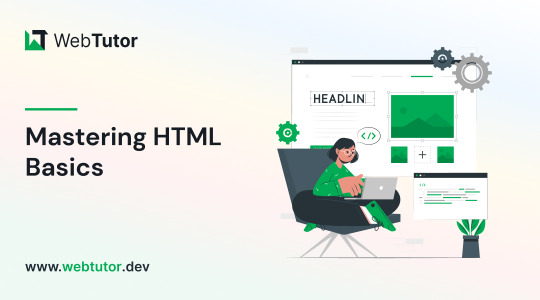
As the foundation of web development, HTML (Hypertext Markup Language) is a crucial language for anyone looking to create websites or web applications. Whether you are a beginner just starting out or an experienced developer looking to brush up on your skills, WebTutor.dev offers an exceptional resource for mastering HTML basics. In this blog post, we will delve into the wealth of knowledge available at https://webtutor.dev/html/html-basic, and explore how this comprehensive guide can help you level up your HTML skills.
Structured Learning for Beginners
If you are new to web development and HTML, WebTutor.dev HTML Basics guide is an excellent starting point. The guide is structured in a way that is easy to follow, with concepts introduced in a logical order that builds upon each other. From understanding the basic structure of an HTML document to working with various HTML elements, HTML attributes, and HTML tags, the guide covers all the essentials in a beginner-friendly manner.
One of the strengths of the guide is its practical approach to learning. Each concept is accompanied by clear explanations, examples, and demonstrations of how to implement it in real-world scenarios. This hands-on approach allows beginners to apply what they have learned and see the results in their web pages, which helps solidify their understanding of HTML concepts.
Comprehensive Coverage of HTML Basics
The HTML Basics guide on WebTutor.dev covers a wide range of topics, providing a comprehensive overview of HTML fundamentals. Some of the key topics covered in the guide include:
HTML Document Structure: Understanding the basic structure of an HTML document, including the <!DOCTYPE>, <html>, <head>, and <body> elements.
HTML Elements: Learning about different HTML elements such as headings, paragraphs, links, images, lists, tables, forms, and more, and how to use them correctly.
HTML Attributes: Understanding HTML attributes and how to use them to customize the behavior and appearance of HTML elements.
HTML Tags: Exploring various HTML tags and their proper usage, including opening and closing tags, nested tags, and void tags.
HTML Forms: Understanding how to create forms in HTML to collect user input, including different form elements such as text inputs, checkboxes, radio buttons, and dropdown menus.
HTML Semantics: Learning about the semantic elements in HTML, such as <header>, <nav>, <main>, <article>, <aside>, and <footer>, and how they contribute to building accessible and SEO-friendly websites.
HTML Validation: Understanding the importance of HTML validation and how to validate HTML documents using online tools.
In addition to these topics, the guide also covers other essential HTML concepts such as doctypes, character encoding, linking to external resources, and best practices for writing clean and maintainable HTML code.
Interactive Learning Experience
WebTutor.dev offers an interactive learning experience with its HTML Basics guide. The guide includes numerous examples and exercises that allow learners to practice what they've learned in a hands-on manner. Learners can experiment with the code examples provided in the guide, make modifications, and see the results in real-time. This interactive approach helps reinforce the concepts and allows learners to gain confidence in their HTML skills.
Moreover, WebTutor.dev provides a code playground where learners can write HTML code, view the output, and experiment with different HTML concepts in a safe environment. This interactive feature allows learners to practice coding without the need for any additional tools or software, making it a convenient and user-friendly learning experience.
Up-to-Date and Accessible Learning Material
WebTutor.dev HTML Basics guide is regularly updated to ensure that it reflects the latest best practices and standards in HTML development. This means that learners can trust the content to be current and relevant to the latest web development trends. The guide is also designed to be accessible, with clear explanations, examples, and demonstrations that cater to different learning styles. Whether you're a visual learner who prefers diagrams and illustrations or a hands-on learner who wants to experiment with code, WebTutor.dev HTML Basics guide provides a variety of learning materials to accommodate different learning preferences.
Community Support and Resources
WebTutor.dev goes beyond just providing a comprehensive guide to HTML basics. The website also offers a supportive community where learners can connect with other web developers, ask questions, and seek help when needed. This community aspect adds an extra layer of support to the learning experience, as learners can learn from each other's experiences, collaborate on projects, and grow together as developers.
In addition to the community support, WebTutor.dev also provides additional resources such as cheat sheets, reference guides, and tutorials on related web development technologies, which can complement the HTML Basics guide and further enhance the learning journey.
Conclusion
Mastering HTML basics is essential for anyone interested in web development, and WebTutor.dev HTML Basics guide is a valuable resource for achieving that goal. With its structured learning approach, comprehensive coverage of HTML fundamentals, interactive learning experience, up-to-date and accessible materials, and community support, WebTutor.dev offers a robust and effective platform for learning HTML.
Whether you are a beginner just starting out or an experienced developer looking to refresh your HTML skills, WebTutor.dev HTML Basics guide is a valuable tool that can help you strengthen your foundation in HTML and set you on the path to becoming a proficient web developer. So, head over to https://webtutor.dev/html/html-basic, dive into the guide, and unlock the power of HTML for your web development projects. Happy coding!
#HTML tutorial for beginners#HTML basics for web developers#HTML tags and elements#Learn HTML coding#HTML web development tutorial#Basic HTML syntax#HTML markup for beginners#HTML coding for websites#Essential HTML concepts#Beginner-friendly HTML tutorial#Introduction to HTML coding#HTML for web designers#HTML syntax and elements explained#HTML for beginners with examples#HTML fundamentals for developers#HTML coding tutorial#HTML markup tutorial#Basic HTML tags explained#Beginner's guide to HTML#HTML syntax tutorial#Learn HTML from scratch#HTML for beginners tutorial#HTML coding basics#HTML web development basics#Understanding HTML elements#HTML structure and syntax#HTML coding for beginners#Basic HTML coding examples#HTML tutorial for web designers#Building websites with HTML
2 notes
·
View notes
Text
HTML for Beginners: Easy-to-Follow Tutorial to Kickstart Your Web Development Journey
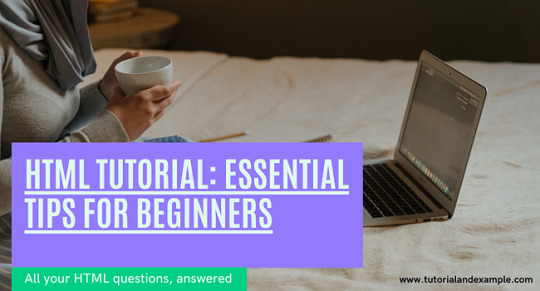
If you are interested in building websites, learning HTML (HyperText Markup Language) is the perfect place to begin. This HTML tutorial for beginners will help you understand the basics of web design in simple terms.
What is HTML? HTML is the foundation of all web pages. It’s a language that uses "tags" to organize and display content like text, images, links, and more. When you visit any website, what you see on the screen is made possible through HTML.
Why Learn HTML? HTML is easy to learn and essential for anyone who wants to design or edit websites. Even if you're planning to become a front-end or back-end developer, understanding HTML is crucial. It helps you control how web pages are structured and displayed.
Basic Structure of a Web Page An HTML page typically includes the following:
Headings – To define titles and subheadings on your web page.
Paragraphs – To add blocks of text content.
Links – To connect your web page to other pages or websites.
Images – To make your page more engaging.
How to Get Started with HTML You don’t need any special software to learn HTML. You can start with a simple text editor (like Notepad) and a web browser (like Chrome). Write your content, save it, and open it in the browser to see your web page come to life.
For a detailed step-by-step guide, visit HTML Tutorial for Beginners. Happy learning!
0 notes
Text
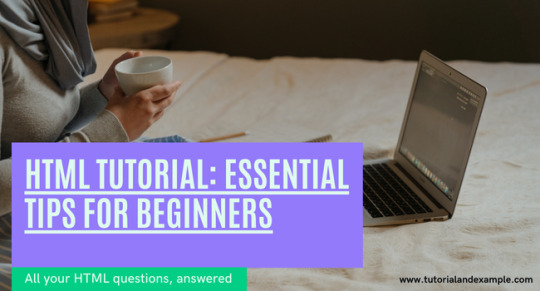
Learn the basics of web development with this HTML tutorial for beginners. Easy-to-follow guide to creating web pages with headings, links, and images. Perfect for new developers starting out!
0 notes
Text
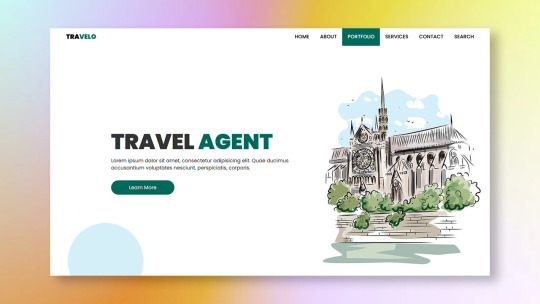
Responsive Header with Full-Screen Search Box
#full-screen header#html css#divinector#webdesign#frontenddevelopment#css3#css#html#learn to code#learn css#css tutorial#html tutorial for beginners#responsive web design#frontend#responsive header
1 note
·
View note
Text
HTML tutorial in Hindi | HTML Tools | HTML Document Structure
HTML Tools HTML tutorial in Hindi – HTML में Code लिखने और Run करने के लिये कुछ Basic Tools की जरूरत होती है जो लगभग सारे Computers में पहले से ही Installed होते हैं। इसके लिये mainly दो प्रकार के Tools की जरूरत पडती है: Text Editor (जैसे Notepad, Notepad++, Dreamweaver, Coffee Cup, Visual Studio Code आदि) Web Browser (जैसे Internet Explorer, Google Chrome, Firefox, Safari, Opera आदि) Text…
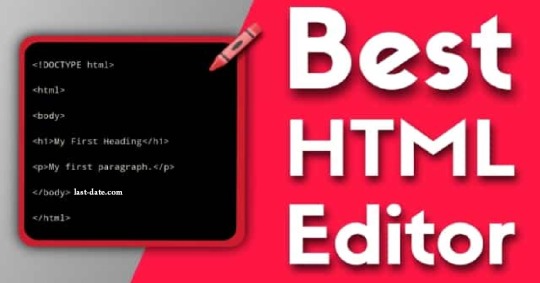
View On WordPress
#complete html tutorial in hindi#css html tutorial in hindi#html#html course in hindi#html css tutorial for beginners in hindi#html css tutorial in hindi#html full course in hindi#html hindi tutorial#html in hindi#html in one video#html in one video in hindi#html tutorial#html tutorial for beginners#html tutorial for beginners in hindi#html tutorial in hindi#html tutorials in hindi#learn html#learn html in hindi#what is html in hindi
0 notes
Text
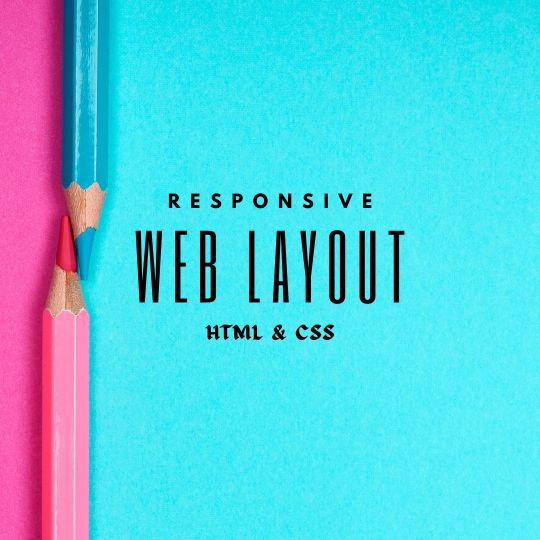
Responsive Web Layout Design
#responsive web design#html css#frontend#css#html#css3#frontenddevelopment#webdesign#responsivedesign#neduzone#create a website#responsive design#css tutorial#css tutorial for beginners
9 notes
·
View notes
Text
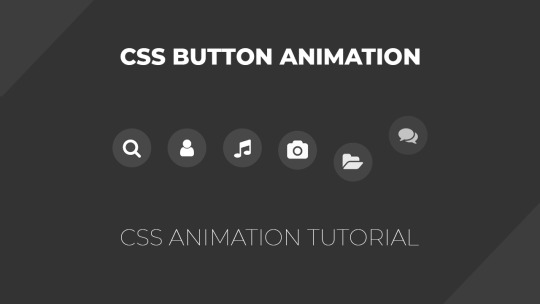
CSS Button Animation
#css button animation#css animation tutorial#codenewbies#frontenddevelopment#html css#html5 css3#css animation examples#pure css animation#webdesign#css#css tutorial for beginners#animation html css
3 notes
·
View notes
Text
HOW TO ADD LINKS TO YOUR BIO

Paste the above code into your bio, replacing the link section with the full link and the text section with your desired text. Be sure not to leave a space when copying over.
If it's breaking, or you're lost, check this post here.
*note: these links will only appear in your mobile/automatic theme. if you have a desktop theme with a custom description this method will still work.
#tumblr themes#themes#tumblr pages#tumblr codes#beginner coding#page theme#tutorial#coding#how to#for beginners#links#css#html#on the old stone wall#tumblr#tumblr tips#links in bio#how to put links in bio
55 notes
·
View notes
Text
felt like i was going crazy yesterday trying to set up a login system for this website 😭 it was like i was back in college again!
#im using supabase for auth and i was like someone pls...show me how to do this...with just vanilla js#every tutorial is with like react or next#im trying to do this site with just html css and js (and php)#so i can learn#and later if i wanna move things to a framework i wont be completely lost if something breaks!#but yea i pretty much settled on like using react for part of the website so i can get this login set up#i found some videos and articles so im pretty sure its possible#other options is to use the archived js example i finally found for supabase auth but#it scares me that its archived#fingers crossed next time i code this works#i think this has to be the hardest part of the coding#i wish i could do my own auth thing but thats super dangerous as a beginner#anyways if i get stuck again ill just try the archived js example#and if im still stuck...#idk find another auth thing to use ig#BF RALLY WILL HAPPEN IT WILL#if it doesnt it means i died or someshit lol#but yea im mainly just like ugh about react cause i seriously dont need all those libraries added rn#this sites not supposed to be that complicated imo like yea its dynamic but its like a neopets like thing#the partial react thing doesnt rely on installing a bunch of stuff (i think)#so maybe we r good#????#web development#webdev#coding#codebreakers#if someone has the magic video to hand hold me through these pls send lol
2 notes
·
View notes
Text
Learn HTML and CSS: A Comprehensive Guide for Beginners
Introduction to HTML and CSS
HTML (HyperText Markup Language) and CSS (Cascading Style Sheets) are the core technologies for creating web pages. HTML provides the structure of the page, while CSS defines its style and layout. This guide aims to equip beginners with the essential knowledge to start building and designing web pages.
Why Learn HTML and CSS?
HTML and CSS are fundamental skills for web development. Whether you're looking to create personal websites, start a career in web development, or enhance your current skill set, understanding these technologies is crucial. They form the basis for more advanced languages and frameworks like JavaScript, React, and Angular.
Getting Started with HTML and CSS
To get started, you need a text editor and a web browser. Popular text editors include Visual Studio Code, Sublime Text, and Atom. Browsers like Google Chrome, Firefox, and Safari are excellent for viewing and testing your web pages.
Basic HTML Structure
HTML documents have a basic structure composed of various elements and tags. Here’s a simple example:
html
Copy code
<!DOCTYPE html>
<html>
<head>
<title>My First Web Page</title>
<link rel="stylesheet" type="text/css" href="styles.css">
</head>
<body>
<h1>Welcome to My Web Page</h1>
<p>This is a paragraph of text on my web page.</p>
</body>
</html>
: Declares the document type and HTML version.
: The root element of an HTML page.
: Contains meta-information about the document.
: Connects the HTML to an external CSS file.
: Contains the content of the web page.
Essential HTML Tags
HTML uses various tags to define different parts of a web page:
to : Headings of different levels.
: Paragraph of text.
: Anchor tag for hyperlinks.
: Embeds images.
: Defines divisions or sections.
: Inline container for text.
Creating Your First HTML Page
Follow these steps to create a simple HTML page:
Open your text editor.
Write the basic HTML structure as shown above.
Add a heading with the tag.
Add a paragraph with the tag.
Save the file with a .html extension (e.g., index.html).
Open the file in your web browser to view your web page.
Introduction to CSS
CSS is used to style and layout HTML elements. It can be included within the HTML file using the <style> tag or in a separate .css file linked with the <link> tag.
Basic CSS Syntax
CSS consists of selectors and declarations. Here’s an example:
css
Copy code
h1 {
color: blue;
font-size: 24px;
}
Selector (h1): Specifies the HTML element to be styled.
Declaration Block: Contains one or more declarations, each consisting of a property and a value.
Styling HTML with CSS
To style your HTML elements, you can use different selectors:
Element Selector: Styles all instances of an element.
Class Selector: Styles elements with a specific class.
ID Selector: Styles a single element with a specific ID.
Example:
html
Copy code
<!DOCTYPE html>
<html>
<head>
<title>Styled Page</title>
<link rel="stylesheet" type="text/css" href="styles.css">
</head>
<body>
<h1 class="main-heading">Hello, World!</h1>
<p id="intro">This is an introduction paragraph.</p>
</body>
</html>
In the styles.css file:
css
Copy code
.main-heading {
color: green;
text-align: center;
}
#intro {
font-size: 18px;
color: grey;
}
CSS Layout Techniques
CSS provides several layout techniques to design complex web pages:
Box Model: Defines the structure of an element’s content, padding, border, and margin.
Flexbox: A layout model for arranging items within a container, making it easier to design flexible responsive layouts.
Grid Layout: A two-dimensional layout system for more complex layouts.
Example of Flexbox:
css
Copy code
.container {
display: flex;
justify-content: space-around;
}
.item {
width: 100px;
height: 100px;
background-color: lightblue;
}
Best Practices for Writing HTML and CSS
Semantic HTML: Use HTML tags that describe their meaning clearly (e.g., , , ).
Clean Code: Indent nested elements and use comments for better readability.
Validation: Use tools like the W3C Markup Validation Service to ensure your HTML and CSS are error-free and standards-compliant.
Accessibility: Make sure your website is accessible to all users, including those with disabilities, by using proper HTML tags and attributes.
Free Resources to Learn HTML and CSS
W3Schools: Comprehensive tutorials and references.
MDN Web Docs: Detailed documentation and guides for HTML, CSS, and JavaScript.
Codecademy: Interactive courses on web development.
FreeCodeCamp: Extensive curriculum covering HTML, CSS, and more.
Khan Academy: Lessons on computer programming and web development.
FAQs about Learning HTML and CSS
Q: What is HTML and CSS? A: HTML (HyperText Markup Language) structures web pages, while CSS (Cascading Style Sheets) styles and layouts the web pages.
Q: Why should I learn HTML and CSS? A: Learning HTML and CSS is essential for creating websites, understanding web development frameworks, and progressing to more advanced programming languages.
Q: Do I need prior experience to learn HTML and CSS? A: No prior experience is required. HTML and CSS are beginner-friendly and easy to learn.
Q: How long does it take to learn HTML and CSS? A: The time varies depending on your learning pace. With consistent practice, you can grasp the basics in a few weeks.
Q: Can I create a website using only HTML and CSS? A: Yes, you can create a basic website. For more complex functionality, you'll need to learn JavaScript.
Q: What tools do I need to start learning HTML and CSS? A: You need a text editor (e.g., Visual Studio Code, Sublime Text) and a web browser (e.g., Google Chrome, Firefox).
Q: Are there free resources available to learn HTML and CSS? A: Yes, there are many free resources available online, including W3Schools, MDN Web Docs, Codecademy, FreeCodeCamp, and Khan Academy.
#how to learn html and css#html & css course#html & css tutorial#html and css#html course#html css tutorial#html learn#html learn website#learn html#learn html and css#html and css course#html and css full course#html and css online course#how to learn html and css for beginners
0 notes
Text
Comprehensive HTML Tutorial for Beginners: From Zero to Hero
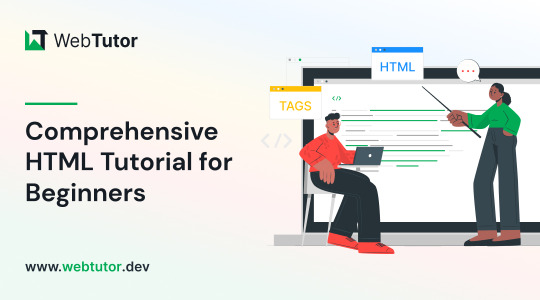
Welcome to WebTutor.dev, your go-to resource for learning HTML online! In this tutorial, we'll cover the fundamentals of HTML (Hypertext Markup Language) with clear explanations and practical examples. Let's dive right in!
Lesson 1: Getting Started with HTML
HTML is the backbone of any web page. It provides the structure and content of a webpage by using tags and elements. Here's a simple example of an HTML document:
<!DOCTYPE html>
<html>
<head>
<title>My First Web Page</title>
</head>
<body>
<h1>Welcome to WebTutor.dev!</h1>
<p>This is a paragraph of text.</p>
</body>
</html>
Let's break it down:
<!DOCTYPE html>: This declaration specifies that the document is an HTML5 document.
<html>: The root element of an HTML page.
<head>: Contains meta information about the webpage, such as the title.
<title>: Sets the title displayed in the browser's title bar.
<body>: The main content of the webpage.
<h1>: A heading element, in this case, the main heading of the page.
<p>: A paragraph element containing text.
Lesson 2: Structuring Content with HTML Tags
HTML offers a wide range of tags to structure and organize content. Here are some commonly used tags:
<h1> to <h6>: Headings of different levels, with <h1> being the highest.
<p>: Paragraphs of text.
<a href="https://www.example.com">Link</a>: Creates a hyperlink to another webpage.
<img src="image.jpg" alt="Description">: Inserts an image into the webpage.
<ul> and <ol>: Unordered and ordered lists, respectively.
<li>: List items inside <ul> or <ol>.
Lesson 3: Adding Styling and Formatting
HTML alone provides the structure of a webpage, but CSS (Cascading Style Sheets) is used to add visual styling and formatting. Here's an example of applying CSS to HTML:
Example
<!DOCTYPE html>
<html>
<head>
<title>Styling Example</title>
<style>
h1 {
color: blue;
font-size: 24px;
}
p {
font-family: Arial, sans-serif;
}
</style>
</head>
<body>
<h1>Welcome to WebTutor.dev!</h1>
<p>This is a styled paragraph of text.</p>
</body>
</html>
In this example, we've added a <style> block within the <head> section. We then define CSS rules to style the <h1> and <p> elements accordingly.
Lesson 4: Building Forms with HTML
HTML forms enable user interaction on webpages. Here's an example of a simple form:
<!DOCTYPE html>
<html>
<head>
<title>Form Example</title>
</head>
<body>
<h1>Sign Up</h1>
<form>
<label for="name">Name:</label>
<input type="text" id="name" name="name" required>
<br>
<label for="email">Email:</label>
<input type="email" id="email" name="email" required>
<br>
<input type="submit" value="Submit">
</form>
</body>
</html>
In this form example, we have input fields for name and email, along with a submit button. The required attribute ensures that the user must provide information in these fields before submitting the form.
Congratulations! You've completed the introductory tutorial on HTML. By understanding these core concepts and practicing with more examples, you'll be well on your way to building impressive webpages. We encourage you to explore more topics such as advanced HTML elements, responsive design, and integrating HTML with other technologies. Visit WebTutor.dev for further tutorials, resources, and community support to enhance your HTML skills. Happy coding!
#HTML Tutorial for Beginners#learning HTML online#fundamentals of HTML#learn to code for free#coding course online#Online Web Tutorial#learn coding for free#online tutorial#learn code#learn code for free#learn online coding#best online platform for learning coding#best place to learn to code online#Learn Free HTML code#HTML introduction#Learn HTML#Free HTML Tutorial#html tutorial#free online HTML editor
0 notes
Text
#Web development guide#Beginner web development#Web development tutorial#Website creation tips#HTML CSS JavaScript#Learning web development#Step-by-step web development#Web development basics#Building websites#Frontend development#Backend development#Web development resources#Web development for beginners#DIY web development#Web development skills
0 notes
Text

Responsive Image Gallery with Lightbox Effect
#responsive image gallery#lightbox effect#responsive web design#css image gallery#html css#learn to code#code#frontenddevelopment#css#html#css3#divinector#css tutorial#css for beginners
5 notes
·
View notes
Text
CSS Mix Blend Mode
#css mix blend mode#css effects#css tricks#html css#frontend#css#html#css3#frontenddevelopment#css image effects#neduzone#basic css tutorial#css for beginners#css tutorial#css3 tutorial
2 notes
·
View notes
